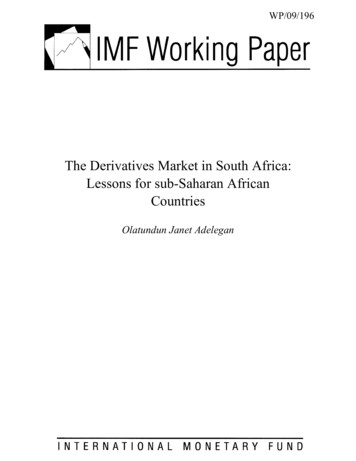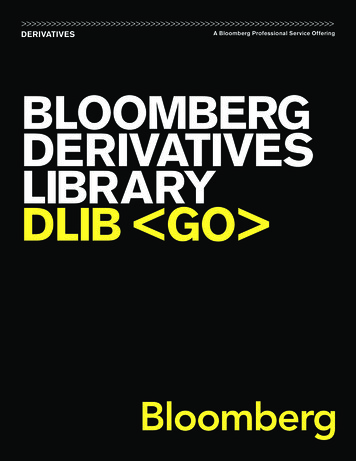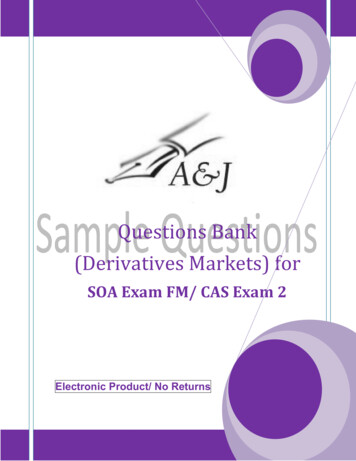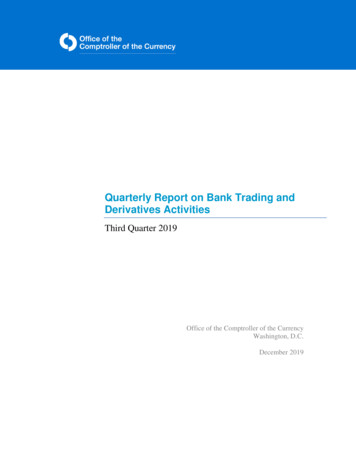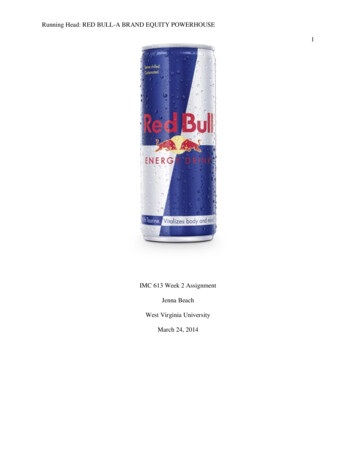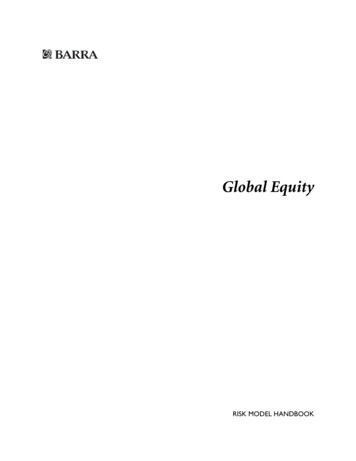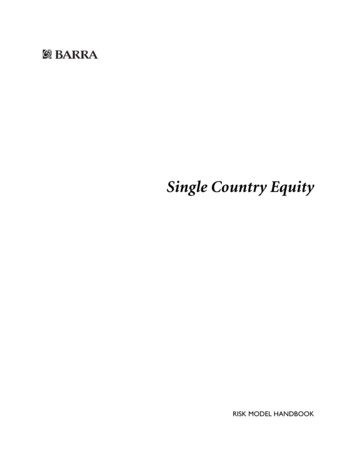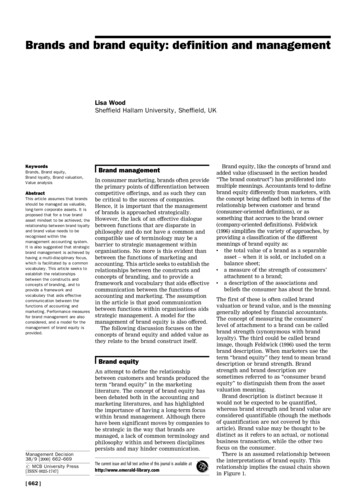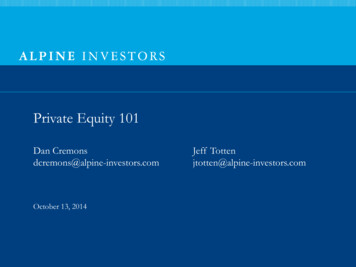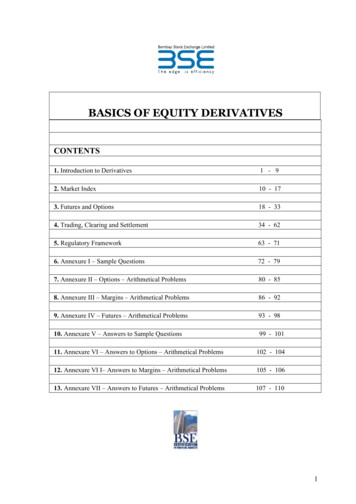
Transcription
BASICS OF EQUITY DERIVATIVESCONTENTS1. Introduction to Derivatives1 - 92. Market Index10 - 173. Futures and Options18 - 334. Trading, Clearing and Settlement34 - 625. Regulatory Framework63 - 716. Annexure I – Sample Questions72 - 797. Annexure II – Options – Arithmetical Problems80 - 858. Annexure III – Margins – Arithmetical Problems86 - 929. Annexure IV – Futures – Arithmetical Problems93 - 9810. Annexure V – Answers to Sample Questions99 - 10111. Annexure VI – Answers to Options – Arithmetical Problems102 - 10412. Annexure VI I– Answers to Margins – Arithmetical Problems105 - 10613. Annexure VII – Answers to Futures – Arithmetical Problems107 - 1101
CHAPTER I - INTRODUCTION TO DERIVATIVESThe emergence of the market for derivative products, most notably forwards, futures andoptions, can be traced back to the willingness of risk-averse economic agents to guardthemselves against uncertainties arising out of fluctuations in asset prices. By their verynature, the financial markets are marked by a very high degree of volatility. Through theuse of derivative products, it is possible to partially or fully transfer price risks by lockingin asset prices. As instruments of risk management, these generally do not influence thefluctuations in the underlying asset prices. However, by locking in asset prices, derivativeproducts minimize the impact of fluctuations in asset prices on the profitability and cashflow situation of risk-averse investors.1.1 DERIVATIVES DEFINEDDerivative is a product whose value is derived from the value of one or more basicvariables, called bases (underlying asset, index, or reference rate), in a contractual manner.The underlying asset can be equity, forex, commodity or any other asset. For example,wheat farmers may wish to sell their harvest at a future date to eliminate the risk of achange in prices by that date. Such a transaction is an example of a derivative. The price ofthis derivative is driven by the spot price of wheat which is the "underlying".In the Indian context the Securities Contracts (Regulation) Act, 1956 (SCRA) defines"derivative" to include1. A security derived from a debt instrument, share, loan whether secured or unsecured,risk instrument or contract for differences or any other form of security.2. A contract which derives its value from the prices, or index of prices, of underlyingsecurities.Derivatives are securities under the SC(R)A and hence the trading of derivatives isgoverned by the regulatory framework under the SC(R)A.EMERGENCE OF FINANCIAL DERIVATIVE PRODUCTSDerivative products initially emerged as hedging devices against fluctuations in commodityprices, and commodity-linked derivatives remained the sole form of such products foralmost three hundred years.Financial derivatives came into spotlight in the post-1970 period due to growing instabilityin the financial markets. However, since their emergence, these products have become verypopular and by 1990s, they accounted for about two-thirds of total transactions inderivative products. In recent years, the market for financial derivatives has growntremendously in terms of variety of instruments available, their complexity and alsoturnover. In the class of equity derivatives the world over, futures and options on stockindices have gained more popularity than on individual stocks, especially amonginstitutional investors, who are major users of index-linked derivatives. Even smallinvestors find these useful due to high correlation of the popular indexes with variousportfolios and ease of use.2
1.2 FACTORS DRIVING THE GROWTH OF DERIVATIVESOver the last three decades, the derivatives market has seen a phenomenal growth. A largevariety of derivative contracts have been launched at exchanges across the world. Some ofthe factors driving the growth of financial derivatives are:1. Increased volatility in asset prices in financial markets,2. Increased integration of national financial markets with the international markets,3. Marked improvement in communication facilities and sharp decline in their costs,4. Development of more sophisticated risk management tools, providing economic agents awider choice of risk management strategies, and5. Innovations in the derivatives markets, which optimally combine the risks and returnsover a large number of financial assets leading to higher returns, reduced risk as well astransactions costs as compared to individual financial assets.1.3 DERIVATIVE PRODUCTSDerivative contracts have several variants. The most common variants are forwards,futures, options and swaps. We take a brief look at various derivatives contracts that havecome to be used.Forwards: A forward contract is a customized contract between two entities, wheresettlement takes place on a specific date in the future at today's pre-agreed price.Futures: A futures contract is an agreement between two parties to buy or sell an asset at acertain time in the future at a certain price. Futures contracts are special types of forwardcontracts in the sense that the former are standardized exchange-traded contracts.Options: Options are of two types - calls and puts. Calls give the buyer the right but not theobligation to buy a given quantity of the underlying asset, at a given price on or before agiven future date. Puts give the buyer the right, but not the obligation to sell a givenquantity of the underlying asset at a given price on or before a given date.Warrants: Options generally have lives of upto one year, the majority of options traded onoptions exchanges having a maximum maturity of nine months. Longer-dated options arecalled warrants and are generally traded over-the-counter.LEAPS: The acronym LEAPS means Long-Term Equity Anticipation Securities. Theseare options having a maturity of upto three years.Baskets: Basket options are options on portfolios of underlying assets. The underlyingasset is usually a moving average of a basket of assets. Equity index options are a form ofbasket options.3
Swaps: Swaps are private agreements between two parties to exchange cash flows in thefuture according to a prearranged formula. They can be regarded as portfolios of forwardcontracts. The two commonly used swaps are: Interest rate swaps: These entail swapping only the interest related cash flowsbetween the parties in the same currency. Currency swaps: These entail swapping both principal and interest between theparties, with the cash flows in one direction being in a different currency than thosein the opposite direction.Swaptions: Swaptions are options to buy or sell a swap that will become operative at theexpiry of the options. Thus a swaption is an option on a forward swap. Rather than havecalls and puts, the swaptions market has receiver swaptions and payer swaptions. Areceiver swaption is an option to receive fixed and pay floating. A payer swaption is anoption to pay fixed and receive floating.1.4 PARTICIPANTS IN THE DERIVATIVES MARKETSThe following three broad categories of participants - hedgers, speculators, and arbitrageurstrade in the derivatives market. Hedgers face risk associated with the price of an asset.They use futures or options markets to reduce or eliminate this risk. Speculators wish to beton future movements in the price of an asset. Futures and options contracts can give theman extra leverage; that is, they can increase both the potential gains and potential losses in aspeculative venture. Arbitrageurs are in business to take advantage of a discrepancybetween prices in two different markets. If, for example, they see the futures price of anasset getting out of line with the cash price, they will take offsetting positions in the twomarkets to lock in a profit.1.5 ECONOMIC FUNCTION OF THE DERIVATIVE MARKETInspite of the fear and criticism with which the derivative markets are commonly looked at,these markets perform a number of economic functions.1. Prices in an organized derivatives market reflect the perception of market participantsabout the future and lead the prices of underlying to the perceived future level. The pricesof derivatives converge with the prices of the underlying at the expiration of the derivativecontract. Thus derivatives help in discovery of future as well as current prices.2. The derivatives market helps to transfer risks from those who have them but may not likethem to those who have an appetite for them.3. Derivatives, due to their inherent nature, are linked to the underlying cash markets. Withthe introduction of derivatives, the underlying market witnesses higher trading volumesbecause of participation by more players who would not otherwise participate for lack of anarrangement to transfer risk.4. Speculative trades shift to a more controlled environment of derivatives market. In theabsence of an organized derivatives market, speculators trade in the underlying cash4
markets. Margining, monitoring and surveillance of the activities of various participantsbecome extremely difficult in these kind of mixed markets.History of derivatives marketsEarly forward contracts in the US addressed merchants' concerns about ensuring that therewere buyers and sellers for commodities. However 'credit risk" remained a seriousproblem. To deal with this problem, a group of Chicago businessmen formed the ChicagoBoard of Trade (CBOT) in 1848. The primary intention of the CBOT was to provide acentralized location known in advance for buyers and sellers to negotiate forward contracts.In 1865, the CBOT went one step further and listed the first 'exchange traded" derivativescontract in the US, these contracts were called 'futures contracts". In 1919, Chicago Butterand Egg Board, a spin-off of CBOT, was reorganized to allow futures trading. Its name waschanged to Chicago Mercantile Exchange (CME). The CBOT and the CME remain the twolargest organized futures exchanges, indeed the two largest "financial" exchanges of anykind in the world today.The first stock index futures contract was traded at Kansas City Board of Trade. Currentlythe most popular stock index futures contract in the world is based on S&P 500 index,traded on Chicago Mercantile Exchange. During the mid eighties, financial futures becamethe most active derivative instruments generating volumes many times more than thecommodity futures. Index futures, futures on T-bills and Euro-Dollar futures are the threemost popular futures contracts traded today. Other popular international exchanges thattrade derivatives are LIFFE in England, DTB in Germany, SGX in Singapore, TIFFE inJapan, MATIF in France, Eurex etc.5. An important incidental benefit that flows from derivatives trading is that it acts as acatalyst for new entrepreneurial activity. The derivatives have a history of attracting manybright, creative, well-educated people with an entrepreneurial attitude. They often energizeothers to create new businesses, new products and new employment opportunities, thebenefit of which are immense. In a nut shell, derivatives markets help increase savings andinvestment in the long run. Transfer of risk enables market participants to expand theirvolume of activity.1.6 EXCHANGE-TRADED vs. OTC DERIVATIVES MARKETSDerivatives have probably been around for as long as people have been trading with oneanother. Forward contracting dates back at least to the 12th century, and may well havebeen around before then. Merchants entered into contracts with one another for futuredelivery of specified amount of commodities at specified price. A primary motivation forpre-arranging a buyer or seller for a stock of commodities in early forward contracts was tolessen the possibility that large swings would inhibit marketing the commodity after aharvest.As the word suggests, derivatives that trade on an exchange are called exchange tradedderivatives, whereas privately negotiated derivative contracts are called OTC contracts.The OTC derivatives markets have witnessed rather sharp growth over the last few years,which has accompanied the modernization of commercial and investment banking and5
globalisation of financial activities. The recent developments in information technologyhave contributed to a great extent to these developments. While both exchange-traded andOTC derivative contracts offer many benefits, the former have rigid structures compared tothe latter. It has been widely discussed that the highly leveraged institutions and their OTCderivative positions were the main cause of turbulence in financial markets in 1998. Theseepisodes of turbulence revealed the risks posed to market stability originating in features ofOTC derivative instruments and markets.The OTC derivatives markets have the following features compared to exchange tradedderivatives:1. The management of counter-party (credit) risk is decentralized and located withinindividual institutions,2. There are no formal centralized limits on individual positions, leverage, or margining,3. There are no formal rules for risk and burden-sharing,4. There are no formal rules or mechanisms for ensuring market stability and integrity, andfor safeguarding the collective interests of market participants, and5. The OTC contracts are generally not regulated by a regulatory authority and theexchange's self-regulatory organization, although they are affected indirectly by nationallegal systems, banking supervision and market surveillance.Some of the features of OTC derivatives markets embody risks to financial marketstability. The following features of OTC derivatives markets can give rise to instability ininstitutions, markets, and the international financial system:(i) the dynamic nature of gross credit exposures;(ii) information asymmetries;(iii) the effects of OTC derivative activities on available aggregate credit;(iv) the high concentration of OTC derivative activities in major institutions; and(v) the central role of OTC derivatives markets in the global financial system.Instability arises when shocks, such as counter-party credit eve
the introduction of derivatives, the underlying market witnesses higher trading volumes because of participation by more players who would not otherwise participate for lack of an arrangement to transfer risk. 4. Speculative trades shift to a more controlled environment of derivatives market. In theFile Size: 751KBPage Count: 109

